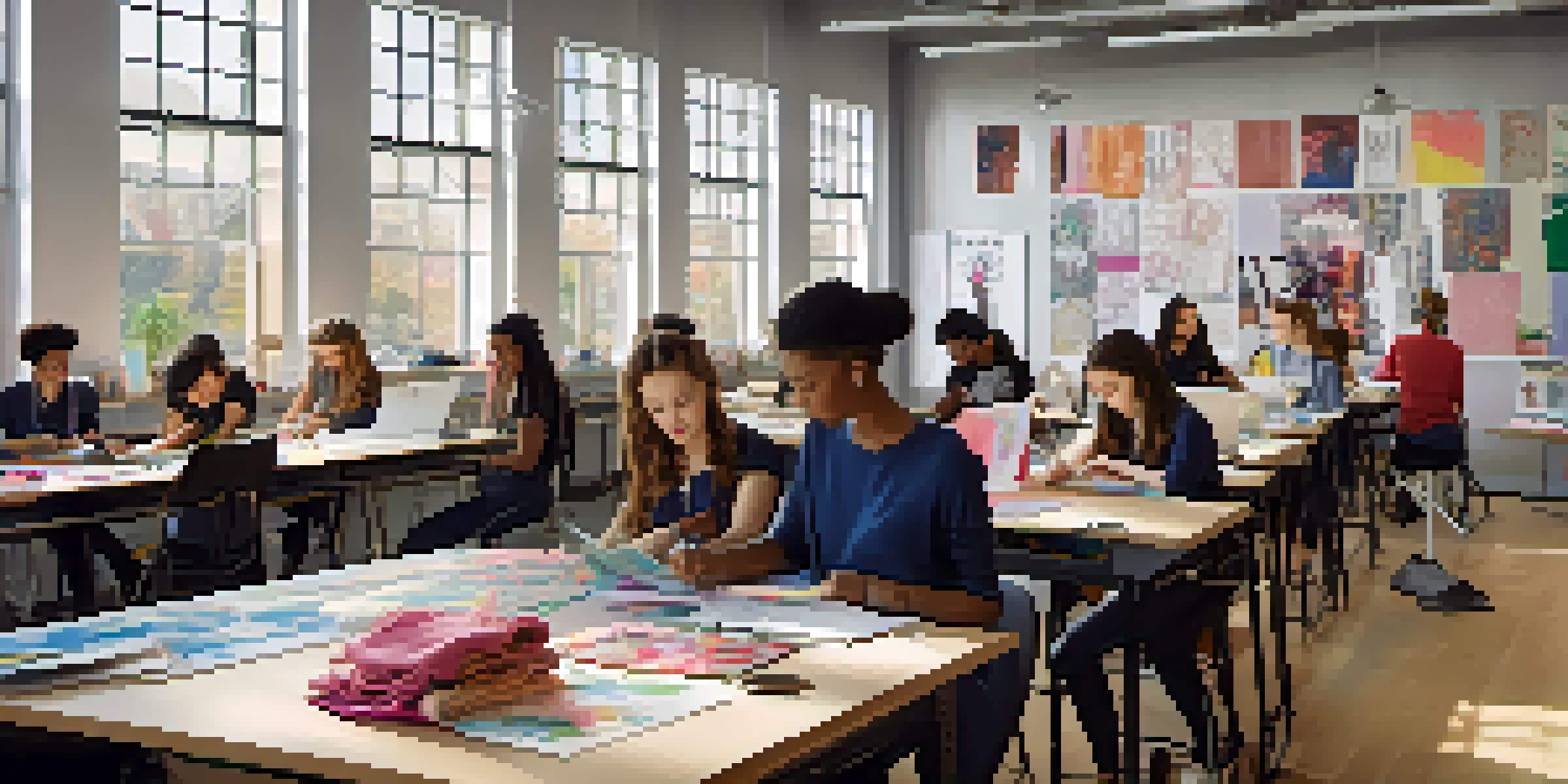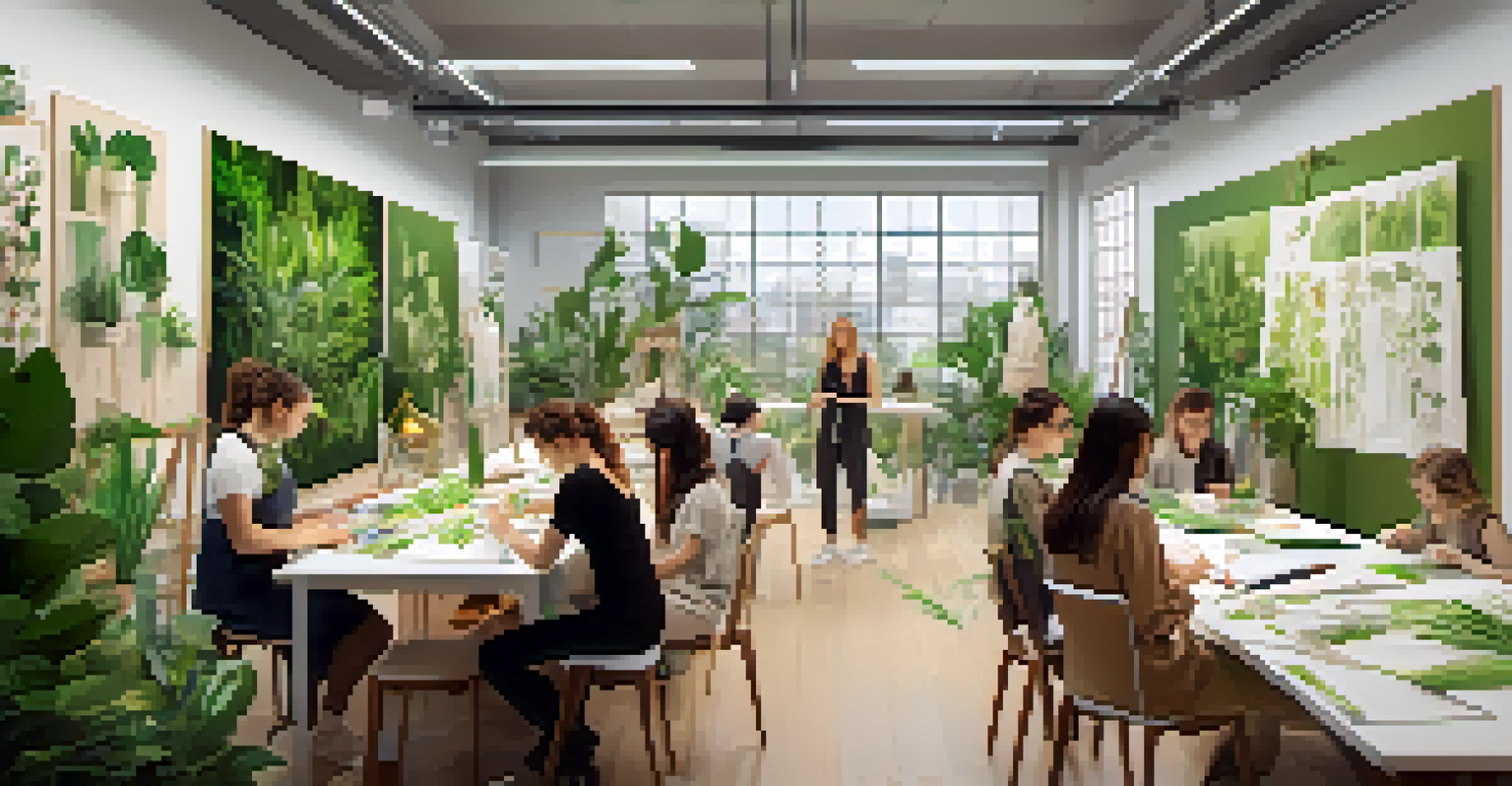Experiential Learning in Fashion: Bridging Theory and Practice

Understanding Experiential Learning in Fashion Education
Experiential learning is a hands-on approach that allows students to engage directly with their field of study. In fashion, this means going beyond textbooks to immerse oneself in the design process, production, and marketing of garments. This learning style emphasizes real-world experience, enabling students to apply theoretical knowledge in practical settings.
Tell me and I forget, teach me and I remember, involve me and I learn.
In the fashion industry, experiential learning can take many forms, such as internships, workshops, and collaborative projects. This not only helps students grasp concepts like fabric selection and garment construction but also fosters critical thinking and creativity. By actively participating in the design process, students learn to navigate the complexities of the fashion world.
Ultimately, experiential learning cultivates a deeper understanding of fashion dynamics, preparing students to become more adaptable professionals. They learn to think on their feet and solve problems in real-time, skills that are invaluable in an ever-evolving industry.
The Role of Internships in Fashion Education
Internships serve as a cornerstone of experiential learning in fashion education. They provide a unique opportunity for students to work alongside industry professionals and gain insights that can't be found in a classroom. This real-world exposure helps bridge the gap between academic theories and practical application.

During internships, students often find themselves immersed in the daily operations of fashion houses, gaining hands-on experience in areas like design, marketing, and retail. These experiences allow them to develop a professional network and acquire skills that are immediately applicable once they graduate. Additionally, they get a taste of the fast-paced environment in which fashion professionals operate.
Experiential Learning is Key
Hands-on experiences in fashion education prepare students for real-world challenges and enhance their understanding of the industry.
Moreover, internships can lead to job opportunities after graduation, making them a crucial stepping stone for aspiring fashion industry leaders. The connections made during these experiences often open doors that help students transition smoothly into their careers.
Workshops and Hands-On Projects Enhance Learning
Workshops and hands-on projects are integral to the experiential learning model in fashion. These interactive sessions allow students to explore various aspects of fashion design, from sketching to sewing, in a collaborative environment. By working on projects, students not only develop technical skills but also learn to communicate their ideas effectively.
The best way to predict the future is to create it.
Participating in workshops with industry experts often introduces students to the latest trends and technologies in fashion. For example, a workshop on sustainable fashion might guide students in creating eco-friendly designs, merging creativity with ethical practices. Such experiences empower students to think critically about their choices and the impact of fashion on the world.
Additionally, these workshops often result in tangible outcomes, like a portfolio piece or a finished garment, which can significantly enhance a student's employability. This blend of skill development and practical application is what makes experiential learning so powerful in the fashion realm.
Collaborative Learning: Fostering Teamwork in Fashion
Collaboration is a key component of experiential learning, especially in the fashion industry where teamwork is essential. Fashion projects often require input from various disciplines, including design, marketing, and production. By collaborating with peers, students learn how to merge different perspectives and skills to create cohesive fashion concepts.
Group projects encourage students to develop their interpersonal skills, such as communication, negotiation, and conflict resolution. These experiences mimic real-world scenarios where designers must work with others to bring their vision to life. Learning to collaborate effectively prepares students for the challenges they will face in their professional careers.
Internships Build Professional Networks
Internships provide invaluable connections and practical insights that bridge the gap between academic theories and industry realities.
Furthermore, collaborative projects often lead to innovative ideas and solutions that might not emerge in solo efforts. This synergy not only enhances the learning experience but also reflects the collaborative nature of the fashion industry itself.
Real-World Challenges: Simulating Industry Scenarios
Experiential learning often involves tackling real-world challenges that fashion professionals face. This simulation approach allows students to engage with complex problems, such as market trends, consumer behavior, and supply chain issues. By analyzing these challenges, students develop problem-solving skills that are crucial for their future careers.
For instance, a fashion design class might simulate the launch of a new clothing line, requiring students to conduct market research, create a marketing plan, and develop the collection. This immersive experience not only enhances their understanding of the fashion business but also equips them with the tools to strategize effectively.
Engaging with real-world scenarios encourages students to think critically and adapt their strategies based on market feedback. This hands-on approach helps bridge the gap between theoretical knowledge and practical application, making them ready for the challenges that await in the fashion industry.
Networking Opportunities: Building Lifelong Connections
Experiential learning in fashion often leads to valuable networking opportunities, which can be pivotal in shaping a student’s career. By interacting with industry professionals during internships, workshops, and collaborative projects, students can build relationships that may benefit them long after graduation. Networking is not just about making contacts; it's about forming genuine connections that can lead to mentorship and job opportunities.
Moreover, attending fashion events, trade shows, and exhibitions as part of experiential learning helps students immerse themselves in the industry culture. These experiences allow them to meet designers, buyers, and other professionals, gaining insights into the industry dynamics. The relationships formed in these environments can often lead to collaborative projects or job offers.
Collaboration Drives Innovation
Working on group projects fosters teamwork and creativity, essential skills for success in the collaborative fashion industry.
In a field as competitive as fashion, having a robust network can significantly enhance a graduate’s chances of success. The connections made during experiential learning can provide essential support, guidance, and opportunities as students transition into their professional lives.
The Future of Fashion Education: Embracing Experiential Learning
As the fashion industry continues to evolve, the importance of experiential learning in education becomes increasingly clear. With rapid technological advancements and shifting consumer behaviors, traditional teaching methods alone may not suffice. Educational institutions are beginning to embrace more experiential approaches to equip students with the skills needed for tomorrow's challenges.
By incorporating practical experiences, such as virtual reality simulations and industry partnerships, fashion schools can offer students a more dynamic learning environment. This not only enhances the educational experience but also ensures that graduates are prepared for the realities of the fashion world. They will be able to adapt to new trends and technologies as they arise.

Ultimately, the future of fashion education lies in its ability to blend theory with practice seamlessly. By prioritizing experiential learning, educational institutions can produce well-rounded professionals who are ready to make their mark on the industry.